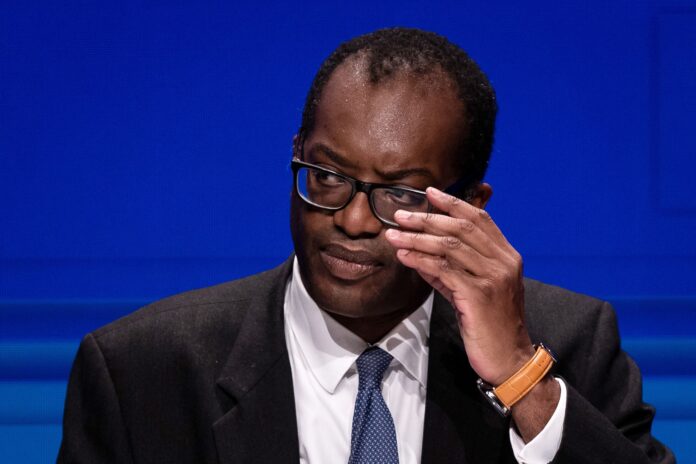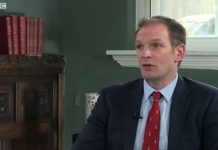The Chancellor would need to announce a fiscal tightening of more than £60 billion just to stabilise debt as a fraction of national income in 2026–27.
Research from the Institute of Fiscal studies out this morning says that cuts on this scale would require some big choices.
By way of illustration, given current economic forecasts, even indexing working-age benefits to growth in earnings for two years (£13 billion cut) and returning investment spending to 2% of national income (£14 billion cut) would leave him needing to cut 15% from non-NHS, non-defence day-to-day public service spending to deliver the required tightening through spending cuts alone.
The Chancellor might, through some such combination, find a way to have debt stabilised in the final year of his forecast without rowing back on any more of his recently announced tax cuts.
But they say, promising a tightening on this scale through spending cuts alone, without actually specifying which budgets would be cut, risks stretching credulity to breaking point at a time when the government’s fiscal strategy is under intense external scrutiny, not least from the financial markets on which government borrowing depends.
There is, they point out, of course, huge uncertainty around exactly how much policy action will be needed given that forecasts for economic growth are highly uncertain in current turbulent times. Faster growth would definitely help, and the government’s focus on this is welcome. But even if the OBR were to assume an additional 0.25 percentage points of growth each year – a big increase – a tightening of approximately £40 billion would still be needed by 2026–27 (equivalent to reversing almost all the ‘mini-Budget’ tax cuts).
The precise figures here are less important than the need for a credible strategy and plan for fiscal sustainability.Growth could turn out better than expected, and there is a case to be made that decisions would be better delayed until things settle down. That might have been a more credible strategy, though, if the Chancellor had not already announced such big permanent tax cuts. His problem is that financial markets are not likely to be impressed by plans predicated either on an unlikely uptick in growth or on vague promises of public spending cuts far into the future.
While we should hope and aim for better growth, the rationale for an independent OBR is to ensure that politically motivated wishful thinking is not incorporated into economic and fiscal forecasts.
Citi’s forecasts suggest slow economic growth over the next five years averaging just 0.8% a year. That reflects a severe terms-of-trade shock which has raised import prices much more quickly than export prices, a historically big squeeze on household budgets, and a supply of both labour and capital that is struggling to respond to swift economic change. A big fall in gas prices could make the outlook significantly rosier. But there are risks on the downside too if inflationary expectations become embedded.
Citi believes that inflation will peak near 12% but that the Bank of England’s policy rate may peak at just 4.5%, below what markets are pricing in. The fact that fiscal and monetary policy are now in clear conflict increases uncertainty and makes the job of the Bank of England harder.
This inflationary episode has been driven largely by a supply-side shock. That makes big hikes in interest rates less appropriate for controlling inflation. Managing it down must remain the key economic objective in the short run. The likelihood of supply shocks hitting more frequently may mean it is time to reassess the framework for economic policymaking and the relative roles of fiscal and monetary policy.
Paul Johnson, Director of IFS, said:
‘Uncertainties about the path of the economy over the next few years make public financeforecasts very difficult indeed. We project borrowing of £100 billion a year in the medium term – but that could be wrong by tens of billions in either direction. A credible fiscal plan will recognise that uncertainty, but cannot ignore the fact that, on a reasonable central forecast, debt is forecast to continue rising in the medium term. The Chancellor has acknowledged that we should be striving to reduce it.
‘It is just about possible to see how Mr Kwarteng could get debt on a stable, or ever-so-slightly falling, path in the final year of his forecast. He could, for example, announce some combination of cuts to working-age benefits and capital investment, plus some unspecified cuts to public services pencilled in for the years after 2025. That might work on paper and spare him having to row back on any more of his mini-Budget tax cuts. But the specifics of the UK government’s fiscal strategy are under more scrutiny by financial markets than at any point in the recent past. The Chancellor should not rely on over-optimistic growth forecasts or promises of unspecified spending cuts. To do so would risk his plans lacking the credibility which recent events have shown to be so important.
‘All that said, we would have sympathy with the Chancellor if he decided that the uncertainties of the present moment are too great to be promising specific future action around public spending. But the same would apply to his recent package of tax cuts. He should not apply that argument asymmetrically.’
Benjamin Nabarro, Chief UK Economist at Citigroup, said:
‘The UK faces a difficult economic outlook with few easy policy answers. Over the coming months, the terms-of-trade shock associated with the conflict in Ukraine will squeeze both firms and households. For the former, the regressive nature of the hit increases the macroeconomic risks. The medium-term outlook for investment remains strikingly weak. Aggressive monetary tightening suggests any meaningful recovery is likely to be pushed into 2025.
‘For policy, the outlook is complicated by ongoing supply disruption. In the near term, further demand stimulus merely risks aggravating the near-term challenges. And with monetary and fiscal policy now working in opposite directions, we think the broader risks around UK monetary-financial stability are growing. In the years ahead, ‘supply shocks’ such as those seen in recent months seem likely to grow more frequent. That may require profound changes in the manner macroeconomic policy is conducted if we are to avoid another decade of stagnation. The UK can ill afford further policy mistakes.’







